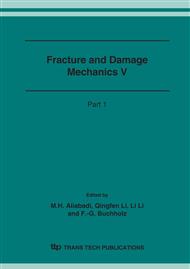[1]
M. Niino, T. Hirai , R. Watanabe, J. Materials. The functionally gradient. J. Jpn. Soc. Comp. Mater. 13 (1) (1987), p.257.
Google Scholar
[2]
A. Kawasaki, R. Watanabe. Finite element analysis of thermal stress of the metal/ceramic multi-layer composites with compositional gradients. Journal of Japan institute of Metals. 51 (1987), pp.525-529.
DOI: 10.2320/jinstmet1952.51.6_525
Google Scholar
[3]
S. Uemura. The activities of FGM on new application. Materials Sciences Forum. 423-425 (2003), pp.1-10.
Google Scholar
[4]
F. Delale, F. Erdogan. The crack problem for a nonhomogeneous plane. J. Appl. Mech. 50 (1983), pp.609-614.
DOI: 10.1115/1.3167098
Google Scholar
[5]
F. Erdogan. Fracture mechanics of functionally graded materials. Composites Engineering. 5 (7) (1995), pp.753-770.
DOI: 10.1016/0961-9526(95)00029-m
Google Scholar
[6]
Jin, Z.H., R.C. Batra. Some basic fracture mechanics concepts in functionally graded materials. J. Mech. Phys. Solids. 44 (8) (1996), pp.1221-1235.
DOI: 10.1016/0022-5096(96)00041-5
Google Scholar
[7]
Jin, Z.H., R.C. Batra. R-curve and strength behavior of functionally graded materials. Mat. Sci. Eng. A 244 (1998), pp.70-76.
Google Scholar
[8]
Gu, P., R.J. Asaro. Cracks in functionally graded materials. Int. J. Solids Struc. 34 (1) (1997), pp.1-17.
Google Scholar
[9]
P.R. Marur, H.V. Tippur. Evaluation of mechanical properties of functionally graded materials. J. Testing and Evaluation. (1998), pp.539-545.
DOI: 10.1520/jte12112j
Google Scholar
[10]
J. Lambros, M.H. Santare, Li, H., G.I. Sapna. A novel technique for the fabrication of laboratory scale functionally graded materials. Exp. Mech. 39(3) (1999), pp.184-190.
DOI: 10.1007/bf02323551
Google Scholar
[11]
V. Parameswaran, A. Shukla. Crack-tip stress field for dynamic fracture in functionally gradient materials. Mechanics of materials. 31 (1999), pp.579-596.
DOI: 10.1016/s0167-6636(99)00025-3
Google Scholar
[12]
V. Parameswaran, A. Shukla. Asymptotic stress fields for stationary cracks along the gradient in functionally graded materials. J. Appl. Mech. 69 (2002), pp.240-243.
DOI: 10.1115/1.1459072
Google Scholar
[13]
Kwang Ho Lee. Characteristics of a crack propagating along the gradient in functionally gradient materials. Int. J. Solids Struc. 41 (2004), pp.2879-2898.
DOI: 10.1016/j.ijsolstr.2004.01.004
Google Scholar
[14]
Zhuang, Z., Guo, Y.J. The analysis for dynamic fracture mechanism in Pipelines. Engineering fracture of mechanics. 64 (1999), pp.271-289.
DOI: 10.1016/s0013-7944(99)00079-x
Google Scholar
[15]
You, X.C., Zhuang, Z., Feng, Y.R., Huo, C.Y., Zhuang, C.J. Crack Arrest in a Rupturing Steel Gas Pipelines. International Journal of Fracture. 123 (2003), pp.1-14.
DOI: 10.1023/b:frac.0000005791.79914.82
Google Scholar


